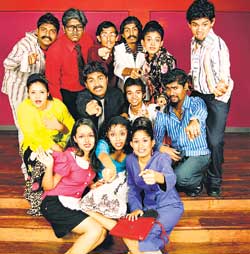
| Playing Rhinoceros Ionesco's most famous play may have a surreal idea at its centre (that people are turning into rhinoceroses), but he uses this to say something about human nature while at the same time creating a drama which is by turns funny, surprising, and fascinating.
The Gateway College production of Eugene Ionesco's Rhinoceros played at the Wendt from August 30 to September 1. My first thought was 'Thank God' it's not another West-end musical or Shakespeare. School drama clubs and theatre groups in Colombo seem obsessed with the two categories, and I have had my fill of sitting through some very half-baked productions in the last year. A very bold choice for a school production, not to mention ambitious and I salute the principal and director, Sashi Mendis Decosta for it. Rhinoceros, set in a small provincial town, was described by Ionesco as 'an anti-Nazi play.' This play demonstrates his disgust as he saw how his friend slowly accepted Nazism. Bérenger, an average middle-class citizen, shows little interest in the fact that a rhinoceros has appeared in the town; he is bored, but other people willingly transform themselves into rhinoceroses. He quarrels with his friend Jean and Daisy, his pretty secretary. In the office Bérenger witnesses the staff gradually join the rhinoceroses. Finally Daisy and he are the only human beings, and when Daisy too turns into a rhinoceros, Bérenger, alone, wonders why he cannot change, and begins to feel that his lack of a horn on his forehead makes him ugly, but ends with defiance against the idea of changing. The full-length play revolves round a semi-autobiographical figure, Bérenger, played by Prasanna Welangoda. A promising actor, yet Welangoda's portrayal of Bérenger relied too much on the words. He was not alone in this. The cast throughout the play tended to rely on merely speaking the lines with very little connection between what was being said, the way it was being said and the actors' bodies. A seeming disconnection between the play's action and the understanding of the cast marred the production. The playing could have been more physical and the second act did use movement to an extent but again this was not sustained. The earlier café scenes packed with good lines were directed and choreographed well, but the actors tended to speak in the same rhythm and at the same pitch and left me begging for a pause between lines. A little too much reliance on diction, left disengaged bodies parading about, pontificating rather than committing themselves to Ionesco's scenes. Jean played by Benign Gerard did have moments where he really had the audience captivated but then moments when he did not connect with his character at all. Again he lost touch with what he was saying perhaps because of the emphasis on diction. Afra Abdeen did show great promise in a very good portrayal of Daisy. The actress injected a lot of energy into the play. Nipuni Fernando was very well cast in her role as was the Logician. Both these actors seemed to be enjoying what they were doing. It was obvious that the production was well thought out, and the stage set, an aspect often over-looked was well designed. (…if I am not mistaken it's the designer's first venture in the theatre.) I felt it contributed to the overall effect and was used well. The dancers and the use of the masks were particularly good. The choreography subtle and well-suited did not take away from the play and added to the entertainment. Though the play is designed to make the audience think it has an ideological point, like one of Sartre's existentialist plays, for example, it doesn't really. The rhinoceroses can be interpreted, as people who have accepted a new totalitarian regime, or perhaps a society that has turned away from human nature, but this identification can only be made vaguely, and it seems to be that Ionesco is writing an absurdist version of this kind of drama, so that the animals do not need to have a meaning. However this aspect of the play is used by Ionesco to comment on society, and Decosta's treatment of the play did manage to bring out these subtleties. At times the play came together very well and managed to keep the audience, partly comprising school kids and troubled teens, entertained. (Not an easy task.) The show was well organized and entertaining. |
| || Front
Page | News
| Editorial
| Columns
| Sports
| Plus
| Financial
Times | International
| Mirror
| TV
Times | Funday
Times | |
| |
Copyright
2006 Wijeya
Newspapers Ltd.Colombo. Sri Lanka. |
